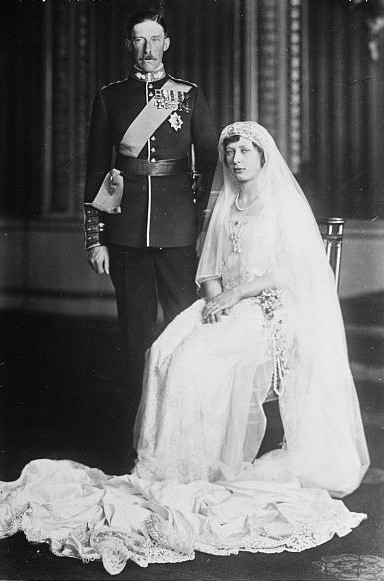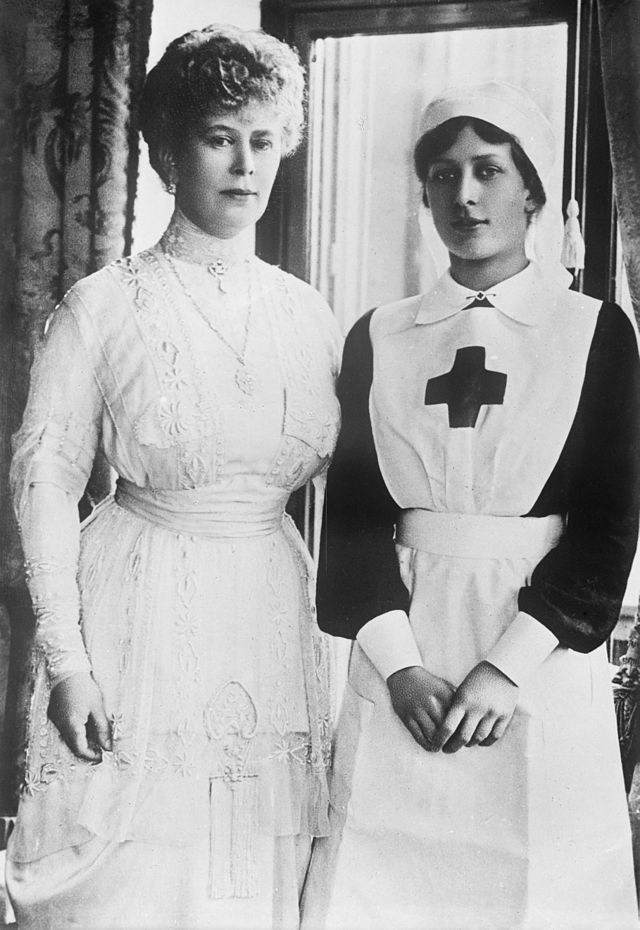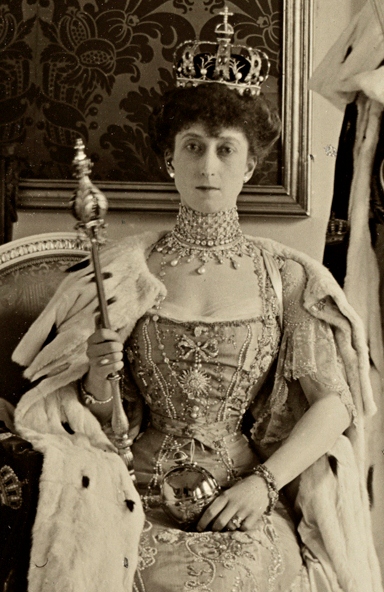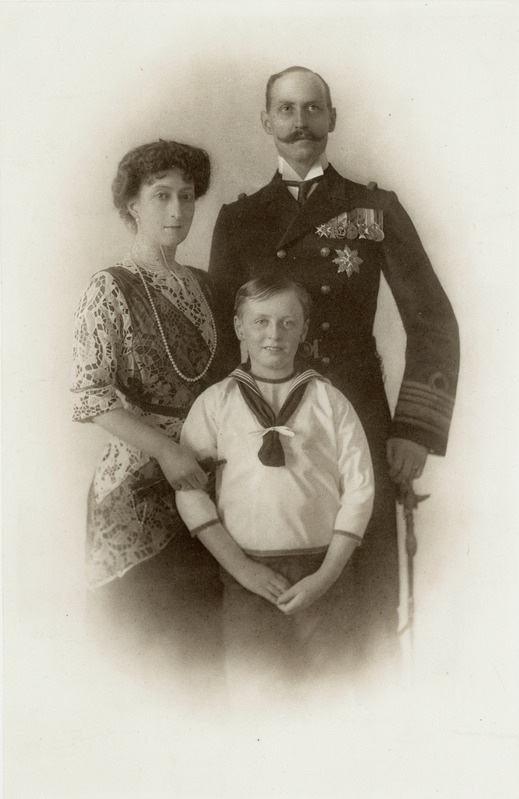by Susan Flantzer © Unofficial Royalty 2014

King George V of the United Kingdom; Credit – Wikipedia
King George V (George Frederick Ernest Albert) was born on June 3, 1865, a month early, at Marlborough House in London, England, the second son and the second of the six children of the future King Edward VII of the United Kingdom and his wife Alexandra of Denmark. His parents, then the Prince and Princess of Wales, wanted to name him George after Prince George, Duke of Cambridge. The baby’s grandmother, Queen Victoria, thought the name George was too modern: “George only came over with the Hanoverian family.” The Prince and Princess of Wales held their ground with the name George but had to agree to add the name Albert, so the baby’s name was George Frederick Ernest Albert. He was called Georgie in the family. At the time of his birth, George was third in the line of succession after his father and his brother Prince Albert Victor (Eddy), and was styled Prince George of Wales. In 1892, George was created Duke of York, and when his father became king in 1901, he automatically became the Duke of Cornwall. He was created Prince of Wales on November 9, 1901.
Prince George was christened at the Private Chapel in Windsor Castle on July 7, 1865. His godparents were:

Prince George in 1870; Photo Credit – Wikipedia
George had five siblings:
George was only seventeen months younger than his brother Eddy. Because of their closeness in age, the two brothers were brought up and educated together. In 1877, Eddy and George joined the Royal Navy’s training ship, HMS Britannia. The brothers remained aboard the Britannia for nearly two years before embarking on a three-year cruise on the HMS Bacchante. Always accompanied by their tutor Mr. Dalton, the brothers visited the Mediterranean, the West Indies, South America, South Africa, Australia, China, and Japan.
In 1883, the brothers were separated. Eddy attended Trinity College, and Cambridge University, and George continued in the Royal Navy. While serving in the Royal Navy, George commanded Torpedo Boat 79 in the waters around the United Kingdom and HMS Thrush in the North American waters. His last active service was the command of HMS Melampus in 1891–92.
George wanted to marry his first cousin Princess Marie of Edinburgh, the daughter of his uncle Prince Alfred, Duke of Edinburgh. His grandmother Queen Victoria, his father, and his uncle all approved of the match, but the mothers did not, and Marie was instructed to refuse when George proposed to her. On December 3, 1891, George’s brother Prince Eddy proposed to Princess Mary of Teck whose mother was a first cousin of Queen Victoria, Princess Mary Adelaide of Cambridge, the youngest child of Prince Adolphus, Duke of Cambridge (the seventh son and tenth child of King George III and Queen Charlotte). The wedding was set for February 27, 1892, but on January 14, 1892, Eddy died of pneumonia.
After the death of Prince Eddy, Mary and George, now second in the line of succession, spent much time together. As time passed and their common grief eased, there was hope that a marriage might take place between them. George proposed to Mary beside a pond in the garden of his sister Louise’s home, East Sheen Lodge, on April 29, 1893. The engagement was announced on May 3, 1893, with the blessing of Queen Victoria. The couple married on July 6, 1893, at the Chapel Royal at St. James’ Palace in London, England, and eventually became the beloved King George V and Queen Mary.

George and Mary on their wedding day; Photo Credit – Wikipedia
George and Mary had six children:
- King Edward VIII (Duke of Windsor after his abdication) (1894-1972), married Wallis Simpson, no children
- King George VI (1895-1952), married Lady Elizabeth Bowes-Lyon, had two daughters
- Mary, Princess Royal (1897-1965), married Henry Lascelles, 6th Earl of Harewood, had two sons
- Prince Henry, Duke of Gloucester (1900-1974), married Lady Alice Montagu-Douglas-Scott, had two sons
- Prince George, Duke of Kent, (1902-1942), married Princess Marina of Greece, had two sons and one daughter
- Prince John (1905-1919)
In 1901, after the accession of King Edward VII, George and Mary toured the British Empire, visiting Malta, Ceylon (now Sri Lanka), South Africa, Australia, New Zealand, and Canada. In 1906, they toured India and then traveled to Spain for the wedding of George’s first cousin Princess Victoria Eugenie of Battenberg to King Alfonso XIII of Spain. Soon afterward, George and Mary traveled to Norway for the coronation of King Haakon VII, George’s first cousin, and Queen Maud, George’s sister.
On May 6, 1910, George’s father King Edward VII died and George became King. His coronation was held at Westminster Abbey on June 22, 1911. In December 1911, King George V and Queen Mary traveled to India for the Delhi Durbar where they were presented as Emperor and Empress of India.
Certainly, the most difficult period of George V’s reign was the years of World War I when the United Kingdom and its allies were at war with the Central Powers, led by the German Empire. Not only did about 1 million people from the United Kingdom and its colonies die, but the war pitted royal family against royal family. George was the first cousin of Wilhelm II, German Emperor and King of Prussia. He was also the first cousin to both Nicholas II, Emperor of All Russia, who was overthrown in 1917, and his wife, born Princess Alix of Hesse and by Rhine. At first, the British government offered asylum to Nicholas and his family, but the offer was later withdrawn. Nicholas and his family remained in Russia and all were executed in 1918. In 1919, Nicholas II’s mother Maria Feodorovna (George’s maternal aunt, born Dagmar of Denmark) and other members of the extended Russian Imperial Family were rescued from Crimea by British ships.

King George V, on the right, with his first cousin Nicholas II, Emperor of All Russia; Credit – Wikipedia
During World War I, on July 17, 1917, King George V issued a proclamation changing the name of the British Royal Family from the German Saxe-Coburg and Gotha to the English Windsor, due to the anti-German sentiment. George’s British relatives relinquished their German titles and styles and adopted British-sounding surnames. The king compensated his male relatives by creating them British peers. All this led George’s cousin Kaiser Wilhelm to remark that he would attend a performance of Shakespeare’s “Merry Wives of Saxe-Coburg” at the earliest opportunity.
George’s relationship with his eldest son and heir Edward, Prince of Wales (known as David in the family, the future King Edward VIII) was strained. The king was disappointed in his son’s failure to settle down and appalled by his affairs with married women. However, he was fond of his second son Prince Albert (known as Bertie in the family, the future King George VI). In 1935, King George V prophetically said of his eldest son, “After I am dead, the boy will ruin himself within 12 months”, and of Prince Albert and his elder daughter Elizabeth, “I pray to God my eldest son will never marry and have children, and that nothing will come between Bertie and Lilibet and the throne.”
In his final years, King George had several problems exacerbated by his habit of smoking including chronic obstructive pulmonary disease and pleurisy. On January 15, 1936, King George V went to bed at Sandringham House complaining of a cold, gradually becoming weaker, and drifting in and out of consciousness. On January 20, when the king was close to death, his doctors issued a bulletin with words that became famous: “The King’s life is moving peacefully towards its close.” As the king lay dying of bronchitis, Bertrand Dawson, 1st Viscount Dawson of Penn, Physician-in-Ordinary to King George V, gave him a lethal injection of cocaine and morphine, thereby hastening the king’s death to ensure that the announcement of the death would appear first in the morning edition of The Times and not in some lesser publication in the afternoon.
King George V lay in state in Westminster Hall in London, England where an estimated 809,000 filed past his casket. As a mark of respect to their father, the king’s four surviving sons, King Edward VIII, Prince Albert, Duke of York, Prince Henry, Duke of Gloucester, and Prince George, Duke of Kent, took the positions of the guards around the catafalque. Known as the Vigil of the Princes, it was repeated in 2002 when the casket of Queen Elizabeth The Queen Mother lay in state in Westminster Hall. Her four grandsons Charles, Prince of Wales, Prince Andrew, Duke of York, Prince Edward, Earl of Wessex, and David Armstrong-Jones, Viscount Linley took the place of the guards. It was then repeated again in 2022 when Queen Elizabeth II’s four children King Charles III, The Princess Royal, The Duke of York, and The Earl of Wessex stood vigil at her coffin. In addition, Queen Elizabeth II’s eight grandchildren, The Prince of Wales, The Duke of Sussex, Peter Phillips, Zara Tindall, Princess Beatrice, Princess Eugenie, Lady Louise Windsor, and Viscount Severn, held a vigil around the coffin of their grandmother. The funeral for King George V was held at St. George’s Chapel at Windsor Castle where he was also interred.
King Edward VIII abdicated less than a year later and his brother Prince Albert, Duke of York ascended the throne, taking the regnal name George VI. King George VI was followed on the throne by his daughter Queen Elizabeth II, the Lilibet her grandfather hoped would become queen.
This article is the intellectual property of Unofficial Royalty and is NOT TO BE COPIED, EDITED, OR POSTED IN ANY FORM ON ANOTHER WEBSITE under any circumstances. It is permissible to use a link that directs to Unofficial Royalty.
Recommended Books
- King George V – Kenneth Rose
- King George V: His Life and Reign – Harold Nicolson
House of Windsor Resources at Unofficial Royalty



































